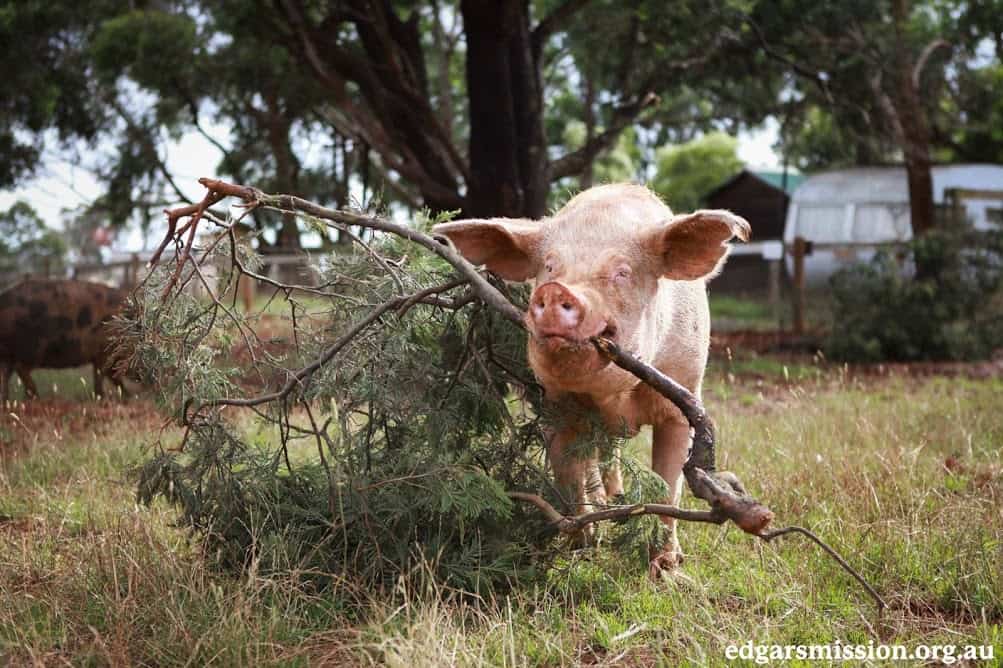
Updated April 14, 2021
Enrichment is often thought of as an “extra” or optional provision for residents. Sanctuary workers are understandably focused on providing the food, water, and housing that is necessary for residents to live. However, we are hoping that by incorporating enrichment as an aspect of general care, the lives of residents will be enriched. This is of particular importance for residents residing in smaller, more confined, or barren living spaces. In cases like these, enrichment can make a world of difference in the lives of residents. No one likes to be bored, including residents, regardless of species!
Developing An Enrichment Plan
It is important to understand the species-specific needs of your residents, in addition to considering their individual needs. An example of a species-specific understanding acknowledges that pigs are very motivated to root and build nests. However, many pig residents that have been rescued experienced interruption of their natural inclinations by being forced into overcrowded, unnatural confinement in barren environments, often on cement flooring. These factors certainly affect how they develop, and some pigs may have temporary or permanent health issues that affect their ability to utilize or enjoy offered enrichment. For this reason, the individual also needs to be considered when developing an enrichment plan.
For example: On an individual level, consider Petal, a maternal adult female pig. Petal was rescued with a large wound on her snout and a scratched cornea, and as a result, she needs to be isolated and her movements must be limited- especially rooting and nesting behavior- for the next week or two. This means she can’t participate in her favorite pastime of rooting around and building a cozy nest out of straw. In this case, developing an enrichment plan should take into account Petal’s species-specific needs (foraging, nest-building, and social bonds) and her individual needs (specifically her motivation to build nests). Setting Petal up in a smaller living spaceThe indoor or outdoor area where an animal resident lives, eats, and rests. and providing enrichment as a means of mental stimulation can assist in her healing. Examples of possible enrichment strategies for Petal include providing Petal with soft blankets to use in lieu of straw (to protect her eye from dust or accidentally poking from the straw) for nest building, and using a soft cloth foraging item (such as a snuffle mat) in place of harder surfaces. Placing a mirror in her living space can also help alleviate the stress of being isolated. In fact, pigs have been shown to be able to find a hidden treat in their living space by using a mirror to locate it! Placing a treat that is hidden except for when Petal looks into the mirror could provide mental stimulation that could take the place of normal rooting behaviors.
When developing an enrichment plan for residents, it’s important to consider the types of behavior in which you’re hoping to see an increase or decrease. For example, if you’re hoping to reduce confrontational behaviors, there are particular enrichment options that are ideal for that, such as providing visual blocks within their living area. Do you wish to increase exploratory behavior? Novel objects and nutritional foraging enrichment may be better suited in this case.
Sample Enrichment Plan
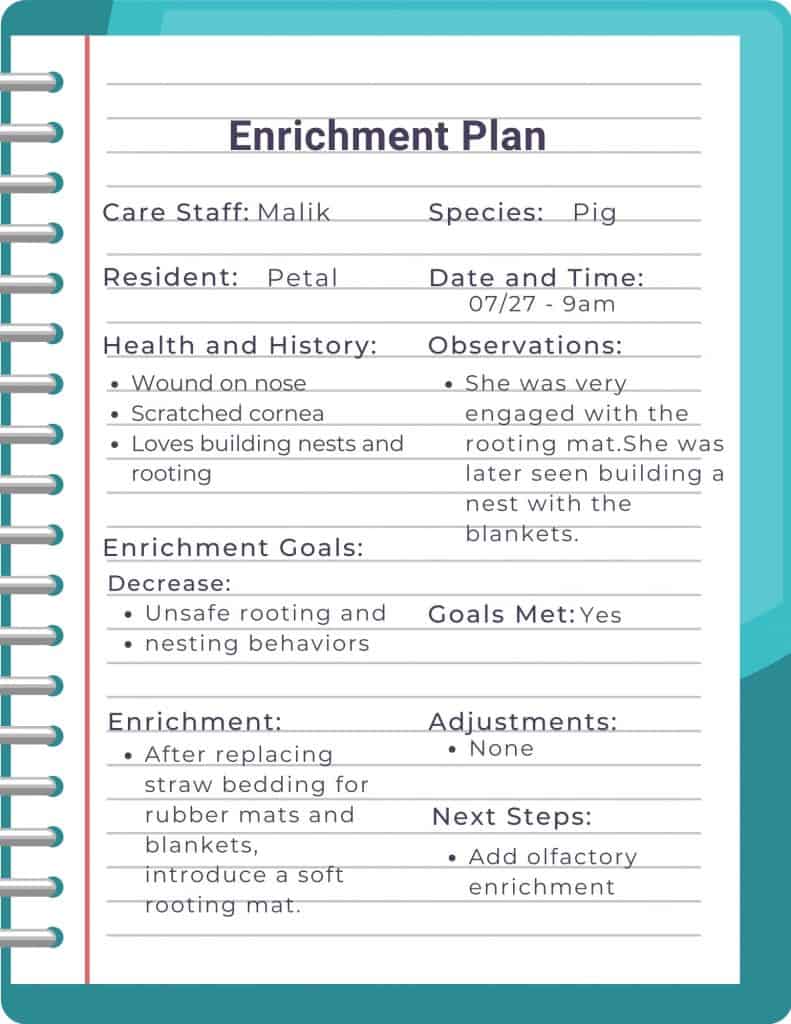
Enrichment can go beyond just offering toys or treats- and that offering enrichment isn’t just a one-time thing! Residents will become bored with certain enrichment that is left in their living space for an extended period, or the same enrichment offered every day (tasty treats being likely an exception to this).
One At A Time!
It is important to only add a single enrichment element at a time when you are first observing and learning whether a resident(s) actually finds it enriching (and for how long they find it enriching before they lose interest). Adding multiple enrichment strategies makes it difficult to get an accurate assessment of the appropriateness of the chosen enrichment. You will be better able to build a schedule when you have more accurate information.
Now that we have covered what an individual enrichment plan looks like, we will cover some of the different types of enrichment for horses and how they could be implemented at your sanctuary.
Observations And Adjustments Are Key!
It’s always important to observe if and how residents use the proffered enrichment. Remember, it is only enrichment if the individual finds it enriching! If they are frightened by something or uninterested in it, then it isn’t enriching.
Social Enrichment
This one may seem obvious, but it’s important to mention. Pigs are social animals and it’s important for them to have access to other pigs. Access to other pigs in and of itself should generally be considered a need. Of course, there are times when this isn’t possible, due to medical issues, group disagreements, or sadly, the death of their herd-mates. In cases like these where direct contact with other members of their species isn’t possible, there are ways that you can enrich their lives during this time:
- Ideally, pigs should be housed with other pigs. If this isn’t possible, then extra steps should be taken to alleviate the stress caused by any sense of isolation.
- Provide visual contact with other pigs (assuming there isn’t any antagonistic behaviors between herd-mates).
- Add a mirror to their living space.
- Include a small amount of soiled bedding (if contagion isn’t an issue) from their original herd space.
- Add a large stuffed animal for piglets.
- Pigs have been known to form strong social bonds with humans as well as some other species, though this should be done thoughtfully and carefully to prevent injury and ensure the well-being of all residents.
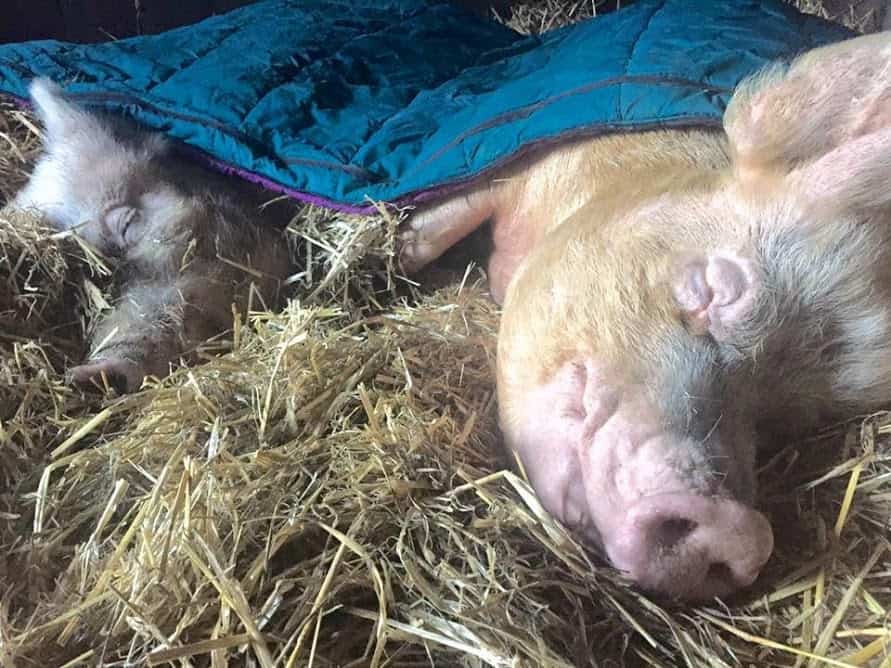
Photo: Edgar’s Mission
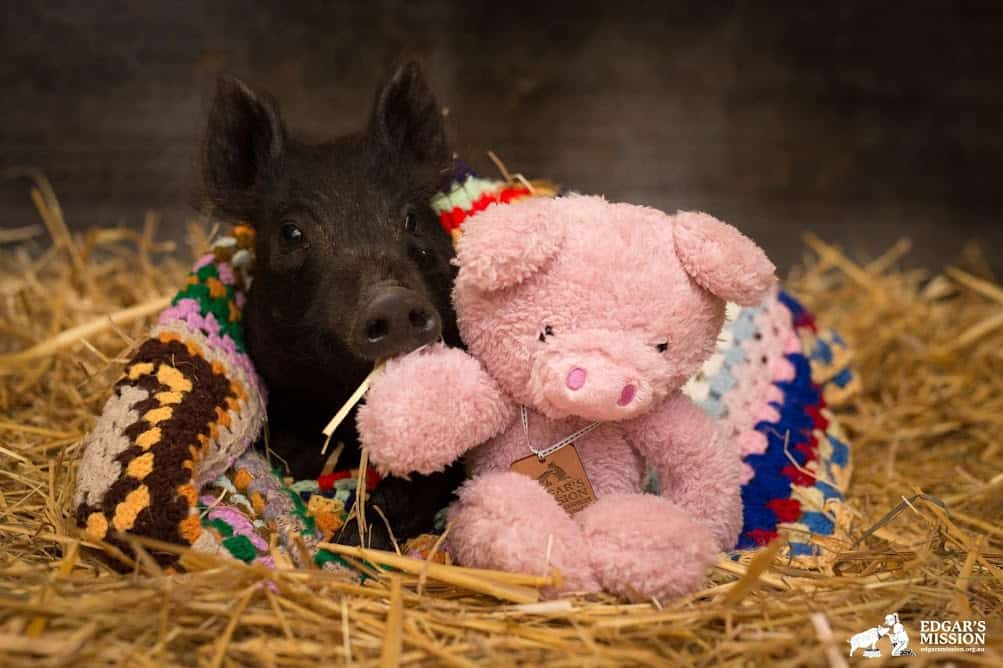
Photo: Edgar’s Mission.
Physical Enrichment
Physical or structural enrichment refers to creating a dynamic living space for residents. This is where you should think about what your resident as a species and individual would want in a living space. Check out our Animal-Centered Design resource to learn more about this. Let’s look at some pig-specific physical enrichment:
- Providing multiple water and food “stations”.
- Provide different piles of substrate like fresh dirt, piles of leaves, or pig-safe mulch.
- Add a nice mud wallow!
- Set up self grooming stations.
- Partition their outdoor living space and rotate where they have access to.
- Add pig-safe logs and old trees.
- Add new features to their environment on a schedule.
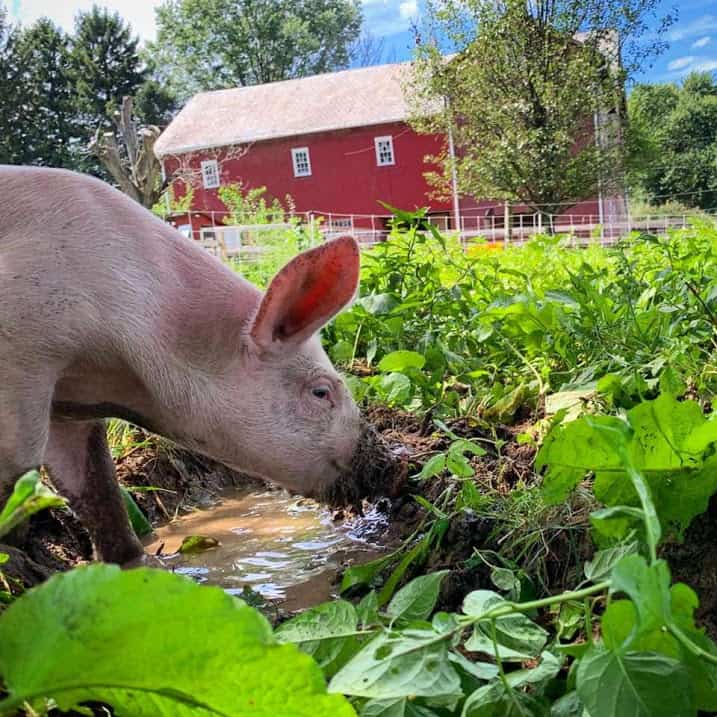
Photo: Lancaster Farm Sanctuary
Nutritional Enrichment
This is a fun one! We all know everyone loves a good meal, or better yet, a tasty treat!
Remember, some pig residents may be uneasy or fearful of new items in their living spaces. As such, it is vital to know your residents as individuals and ensure that you introduce new things in ways that give them plenty of space to avoid going near the items, and does not prevent them from accessing important resources such as water, food, or shelter. Additionally, ensure you provide enough enrichment to prevent dominant residents from preventing other residents from accessing the enrichment. This is another area where knowing your residents comes in handy; if you know there have been confrontational behaviors around coveted resources in the past, you need to ensure you are considering this when developing your enrichment plan!
First off, let’s think about natural behaviors for pigs. What is one thing pigs love to do? Root! Keep this in mind when developing enrichment plans for them.
Here is a list of ideas for nutritional enrichment for your pig residents:
- Instead of offering treats in a bowl, bury bits of produce throughout their living space so they get to use their snouts to root around and find their treat. This encourages residents to explore their living spaces, get more exercise, and promotes cognitive development.
- If you don’t have living spaces your pig residents can dig up, don’t worry! Add a kiddie pool or build a wooden rooting area. This can have large smooth stones in it, pack dirt or straw, or bits of branches and other pig-safe debris for residents to dig through. Once you have this, you can hide treats in the rooting area for them to dig up. This one is almost guaranteed to be a hit with your residents!
- Take a large water jug and drill a handful of holes on the side of the jug. This transforms the jug into a food dispenser when the pigs roll and nudge it!
- Another option is to build a stand (design it for the size and temperament of your pig residents) attach a pole going across the stand that has several bottles (water bottles, soda bottles, and others) stung across it. Put treats or grain supplements within so residents have to manipulate them to get the treats to fall out. This is great cognitive stimulation and extends the time they get to eat their tasty treats.
- You can also attach a long rollable PVC pipe with holes cut out to a sturdy wooden base for residents to manipulate with their noses for treats. (Think of a heavy duty paper towel dispenser!)
- You can also use sturdy dog treat dispensing toys like Kongs with supervision. Just be sure parts are not able to be accidentally consumed and regularly inspect them for any damage.
- Another option is a snuffle mat. This is a mat made with material knotted through floor mats that leaves excess material on the top of the mat. Treats can be sprinkled throughout the mat to encourage exploration and natural rooting behaviors. Here is a link to easy instructions from Dogs Trust UK (Yes, dogs can love this too!)
- Enrichment can even be less expensive than the above to make! Take a cardboard box, put holes in it, put treats inside, and place it in the living space!
- Or make paper mache pinatas full of yummy treats, or hang whole pieces of produce from a rope in their living space.
- During the fall, you can ask for donations of non-rotten pumpkins, which make a fun treat as well! Just make sure that potentially painted-on or inked areas are removed prior to feeding them.
- A fun summer enrichment idea is to take a tub of water, chop up pig-friendly produce, and let them bob for treats!
- When temperatures are especially hot, add chopped up produce to a mold, add water and freeze, creating a cool treat that can keep your residents engaged on a hot day. While pigs usually have their heads to the ground as grazers, you can experiment with placing a bit of rope into the mold as well and hanging it for them to investigate and nibble!
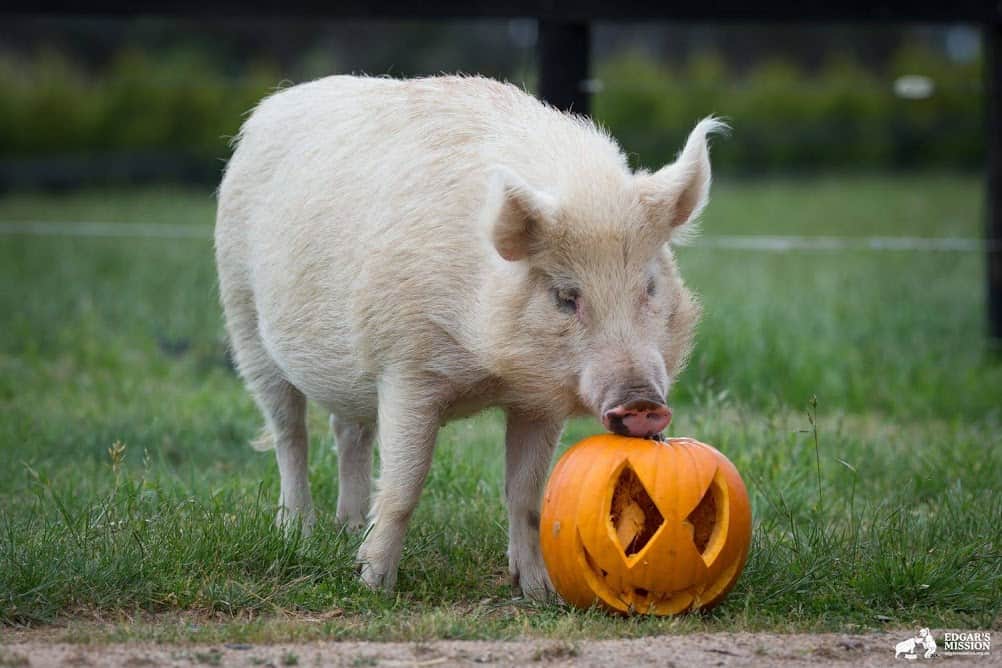
Photo: Edgar’s Mission

Photo: Safe Haven Farm Sanctuary
Sensory Enrichment
Sensory enrichment refers to enrichment that engages the senses. Arguably all enrichment engages the senses, but sensory enrichment focuses in on sight, touch, hearing, and smell. Each can provide interesting experiences for residents!
Visual Enrichment
Research has shown that pigs can benefit from visual forms of enrichment such as mirrors, and even use mirrors to find treats only visible from the mirror! Some studies indicate that many pigs may prefer the colors blue and red over colors closer to yellow. This knowledge can help inform visual enrichment designs. Visual enrichment could include:
- Displaying computer screen savers, particularly those that move.
- Showing television programs or movies, especially for isolated pig residents.
- In other species, images of the same species have been projected onto walls and shown to promote behavioral imitation among the social group. Therefore, projecting scenes of happy pigs could possibly help your resident pigs feel good too. Interest in images can fade after a few weeks, so they should be changed routinely to sustain interest.
- Providing mirrors. Note: Be mindful of individual personalities when adding mirrors. This may not be an ideal form of enrichment for them if they exhibit confrontational behaviors.
- Adding colored buckets or balls (big enough that they aren’t a choking hazard) and see which color they approach more often!
- Introducing any colorful, pig-safe objects can help provide a dynamic environment.
Olfactory Enrichment
Olfactory enrichment is often overlooked when considering enrichment possibilities but can be a very rewarding enrichment offering for pig residents! Pigs have an excellent sense of smell, making olfactory enrichment an excellent choice. In fact, piglets can identify an individual by smelling their urine. Their sense of smell helps pigs find tasty treats, avoid unsafe spaces, and identify other pigs.
- If you need to transfer a pig to a new living space, add a bit of soiled bedding from their previous space for a familiar scent that may make the adjustment a bit easier.
- Try adding scents by adding them to static grooming brushes. Some studies indicate that pigs prefer sweet scents over savory scents. In one case, pigs chose vanilla over rosemary and banana over peanut scented items. In yet another study, piglets were attracted to maple. While pigs in another study showed a preference towards natural earthy smells of grass, moist soil, and dried mushrooms, out of the synthetic fragrances presented, they preferred strawberry over orange, vanilla, and mint.
- Garlic has been documented as both potentially an attractive smell to piglets (who chose a garlic enrichment rope over the unscented rope) though in another study, garlic was repellent to pigs when offered an alternative scented enrichment. Do a little test and see who likes what!
- Changing the aromas is important for novelty and to promote exploratory behavior.
- Rub aromatic herbs on fence posts or other living area surfaces!
- Add scents to other enrichment items to “spice” things up a bit!
Auditory Enrichment
Do you love a good tune? Or have a favorite song that soothes you? The same can be true for pigs!
Pigs have a higher auditory frequency range than humans, and auditory enrichment should be implemented with this in mind! Studies have shown that pigs can become stressed in noisy environments, particularly if the noises are sudden and intermittent or continuous and extremely loud. If you wish to try auditory enrichment, err on the side of caution and start sounds more quietly.
- Pigs have been shown to experience reduced fear when certain music is played for them. The rhythm and type of music makes a big difference. One study showed that pigs had an aversion to loud rock ‘n roll music. Light, relaxed rhythmic music is a better option.
- Pigs verbally communicate quite well with one another. You could try playing happy, calm pig sounds for them. Be mindful of their reactions to determine both a herd’s and individual’s response.
- Adding tactile enrichment that makes sounds while manipulated is another option. For example, you could hang a bell on a string that makes noise when residents touch it.
- Implementing wind chimes with lower octaves could be tried out as well. Remember: it is important to observe their responses to the enrichment and remove it if residents exhibit fear behaviors!
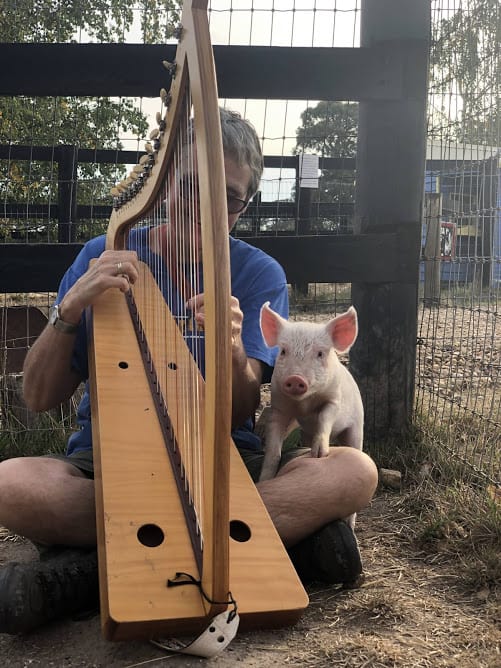
Tactile Enrichment
Pigs are exploratory by nature, and use their mouths and snouts as tools of curiosity. Given this, tactile enrichment is especially important to consider. Studies show that pigs generally prefer more manipulable enrichment items. This means something they can move, lift up with their snout, or change in some other way. This makes sense when you consider that pigs in the wild spend a lot of time using smell, touch, and taste to find food. Keeping this in mind, you might consider the following enrichment activities:
- The great thing is that tactile enrichment doesn’t have to cost a lot of money! A hefty block of wood, or a stump can provide excellent opportunities for pig residents to explore and manipulate these objects.
- Because pigs have been shown to prefer the scent of moist soil, try putting a fresh pile of moist dirt (free from any fertilizers – potting soil is not appropriate) in their living space. Let them experience the scent and texture, giving them an opportunity to root through the pile.
- Pigs like to explore things with their mouths. Hang a solid piece of rope from a fence post or wall for them to mouth, chew on, and pull on. (Be careful that they can’t ingest them). You might make a knot at the end of the rope or attach pig-safe toys. There are large rubber rings that can work for this.
- Adding different piles of substrate for exploration can be stimulating and offer residents a choice. You can learn a lot about individual preferences this way. For example, place a pile of straw, another of mushroom compost, and another of sand, and see what they think! Be sure to observe residents during this time to ensure there is no ingestion of sand.
- Adding balls, boxes, or anything that doesn’t pose a danger but might be interesting for pig residents to touch, taste, or manipulate. Just be sure they aren’t a choking hazard!
- Making paper mache objects they can move around and rip up. Old phone books are another favorite. Just be sure to observe so you can remove any items if residents are trying to eat them.
- Building a few simple foraging boxes with hinged lids and place different enrichment objects or scents inside periodically.
- And, of course, mud is an excellent source of textural enrichment and serves important functions by keeping pigs protected from insects and the sun.
- Water can be another enriching experience. Little pools and sprinklers in the summer are fun options. You may find that some residents enjoy a nice misty shower.
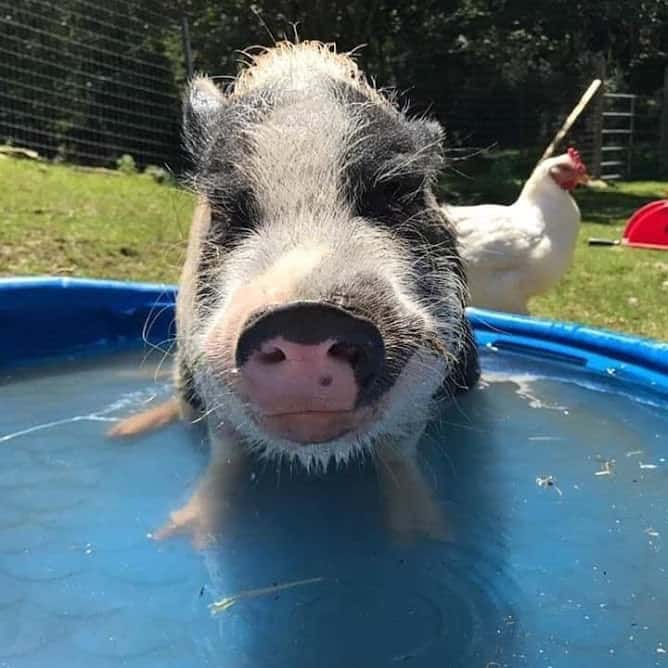
Photo: Safe Haven Farm Sanctuary!
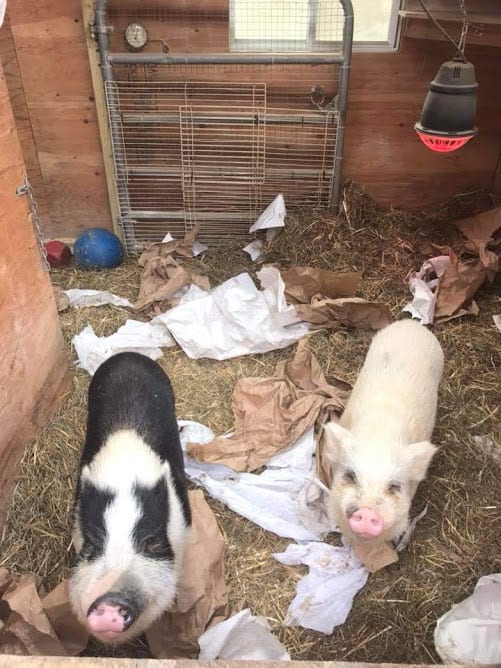
Photo: Safe Haven Farm Sanctuary
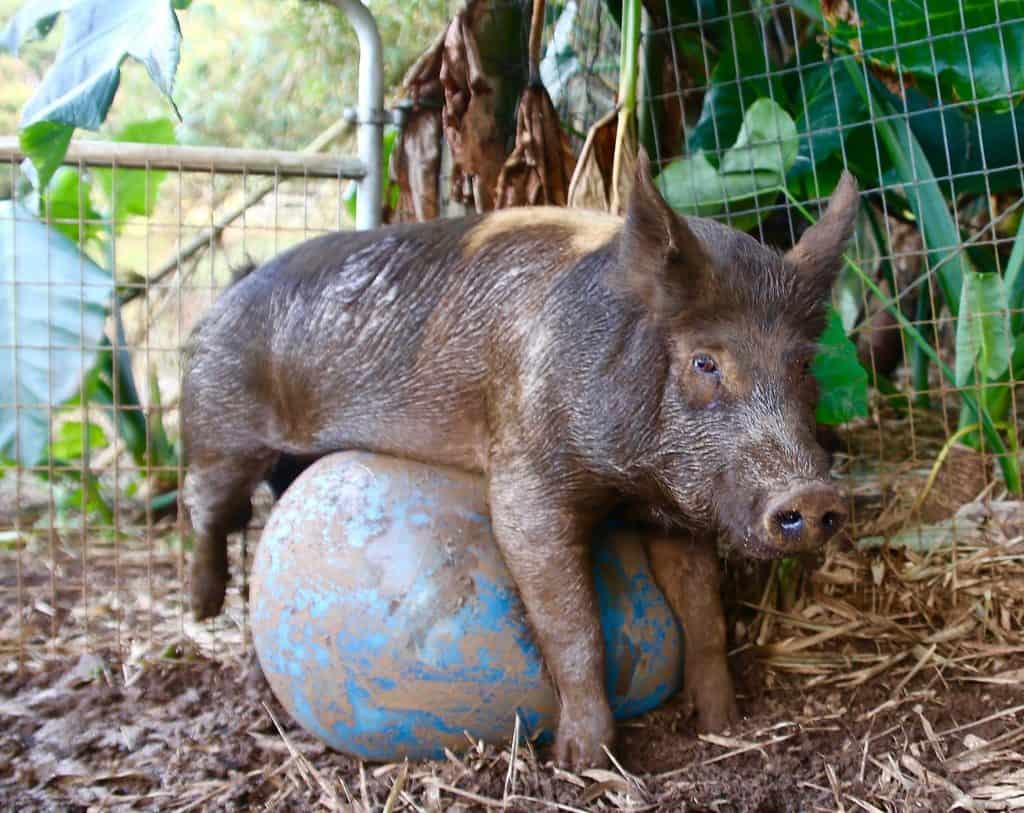
Photo: Leilani Farm Sanctuary
Cognitive Enrichment
Cognitive enrichment involves experiences or environments that encourage curiosity, problem solving behaviors, and learning. A number of enrichment strategies listed above also fall into this category. Puzzle feeders and engaging with curious things in their environment are examples. But let’s touch on another form of cognitive enrichment: positive reinforcement learning (This is often referred to as “training”, but we like to refer to it as clicker “learning”, “play” or “bonding”).
- Positive Reinforcement Engagement
- Many pigs may enjoy interacting with their human caregivers. One way to build a strong human-pig bond and boost cognitive functioning in your pig residents is to engage in clicker “learning”. Clicker learning and positive reinforcement are not interchangeable words. However, a clicker can be a useful tool during positive reinforcement engagement!
- Examples of activities to learn with your pig residents could include learning to choose a specific shape or color of an object, rewarding them with an immediate click and treat. Other examples include learning to push a large ball or plastic barrel around or to even play “soccer” with you (exercise and engagement), ring a bell, open boxes, or even to ease fear or reactivity to medical procedures and transport. This external link provides a brief tutorial on how to engage horses with a clicker. This works for pigs too.
Focus On The Resident
It is important to note that clicker learning or play should only be implemented for the positive experiences that can be provided to your residents. This should not be used to encourage behavior that might be unsafe or exploitative.
Take Notes
Because every pig is an individual, they are likely to have individual responses to enrichment. When you first add enrichment items, be sure to carefully observe the reactions of your residents. To prevent discomfort to new items or enrichment schedules, consider adding novel objects to an area at the side of their living space, or in a space that doesn’t require them walking past the item to go inside, outside, or reach their water or food. If you believe one of your resident herds or individuals may be fearful of certain enrichment, encouraging them to investigate the object while you are sitting and holding the object can help ease fears. Using food or treats to motivate them to interact with the item is a great way to start. (Remember to use caution when handing out treats to a group of residents. You can quickly put yourself in an unsafe situation!) Giving your residents the option to engage or not with enrichment items can be empowering and improve emotional states. Be sure to make notes of any reactions and when their level of interest seems to subside. This will help you know how to best schedule days to change up their enrichment and provide them with a mentally stimulating environment.
Novelty
Novelty can be enriching on its own! Making changes to the “furniture” arrangement, the placement of food, or the addition of balls and toys can all create an interesting and enriching environment for your pig residents. Pigs are clever and become bored after some time with provided enrichment. For this reason, it is important to incorporate “switch it up” days into your residents’ enrichment schedules. As mentioned above, it’s important to take notes on group and individual responses so you can properly tailor enrichment to the interests and needs of your residents.
Building A Schedule
Once you learn more about your residents’ interests, you can build an enrichment schedule to provide varying forms of enrichment as part of your caregiving routine. This will keep things interesting for the pigs and help provide a stimulating and happy life for your residents.
Do you have an exciting enrichment strategy you use with your pigs? Tell us all about it!
SOURCES:
Enrichment Overview | California Potbellied Pig Association, Inc
Enrichment Concepts | California Potbellied Pig Association, Inc
Swine Enrichment | Enrichment Record (Non-Compassionate Source)
Effects Of Environmental Enrichment On Pig Welfare—A Review | Animals (Non-Compassionate Source)
Enriching Sows’ Positive Behavior | National Hog Farmer (Non-Compassionate Source)
Pig Enrichment Affects Immune Response To Disease | FareWell Dock (Non-Compassionate Source)
Colour Preferences In Pigs | Scientific Annals Of Polish Society Of Animal Production (Non-Compassionate Source)
Effect Of Olfactory Stimulation During Suckling On Agonistic Behavior In Weaned Pigs | Journal Of Swine Production (Non-Compassionate Source)
The Influence Of Aromatized Environmental Enrichment Objects With Changeable Aromas On The Behaviour Of Weaned Piglets | Veterinarski Arhiv (Non-Compassionate Source)
Pig’s Behavioral Response In Nursery And Growth Phases To Environmental Enrichment Objects | Spanish Journal Of Agricultural Research (Non-Compassionate Source)
Odors And Pheromones: Influences Of Olfaction On Behavior, Physiology, And Performance To Reduce Stress In Pigs | Texas Tech University (Non-Compassionate Source)
Pigs Learn What A Mirror Image Represents And Use It To Obtain Information | Animal Behavior (Non-Compassionate Source)
The Use Of Garlic Oil For Olfactory Enrichment Increases The Use Of Ropes In Weaned Pigs | Animals (Non-Compassionate Source)
Effect Of Music Rhythm On Growth Performance Of Growing Pigs | Agriculture And Natural Resources (Non-Compassionate Source)
Providing Enrichment For Pigs | Compassion In World Farming (Non-Compassionate Source)
If a source includes the (Non-Compassionate Source) tag, it means that we do not endorse that particular source’s views about animals, even if some of their insights are valuable from a care perspective. See a more detailed explanation here.








